#ecossais
Text

C'est l'heure d'une petite danse !🎶
#digital art#original character#oc#original art#digital drawing#oc male#oc female#kilt#écosse#ecossais#musique#danse
0 notes
Text



Serre-taille "punk", patron de mon cru.
#Serre-taille#Corset#Waist-cincher#Handmade#Fait main#Punk#Tartan#Ecossais#Tissu#Fabric#Brooch#Broche
0 notes
Text
DIRECT. ECOSSE-HONGRIE : LES ECOSSAIS ONT LE PIED SUR LE BALLON
https://rmcsport.bfmtv.com/football/euro/direct-ecosse-hongrie-suivez-le-match-de-l-euro-2024-en-live_LS-202406230143.html
View On WordPress
0 notes
Text
Découvrez des chaussons imprimés écossais sur le site Airplum
Vous cherchez des chaussons imprimé écossais pour homme ? Si la réponse est oui, vous pouvez choisir le modèle WILFRID d’Airplum. L’intérieur en laine maintiendra vos pieds au chaud toute la journée. Si vous souhaitez le commander, sachez que les pointures 41, 42 et 44 ne sont plus disponibles sur la boutique en ligne.

0 notes
Text
Tartan du Clan Campbell - Histoire, Clan, Kilts, et Origine | Kilt écossais

Le tartan Campbell est aussi parfois associé à l'ancien tartan Blackwatch parce qu'il a quelques ressemblances dans le motif. Il est apparu dans les années 1880 pour la toute première fois. Le chef du Clan Campbell n'était pas satisfait du tartan et le chef du Clan Campbell qui est le chef du Clan Campbell est Torquhil Campbell 13ème Duc d'Argyll qui est bien connu pour son jeu de Polo de l'Eléphant. n'était pas impressionné "Laissez-moi me débarrasser entièrement et complètement, de cette notion qu'il y avait un Campbell d'Argyll" [tartan]. On peut dire que le Sixième Duc d'Argyll a introduit une ligne blanche dans son simple tartan Campbell afin de le distinguer des Campbell.
Origine et histoire du Clan Campbell
Le nom Campbell, dit-on, a été déduit du mot gaélique signifiant "bouche en colère" ou "bouche tordue". Cela peut être dû au fait qu'un ancêtre avait une anomalie physique. Avant que ce nom de famille ne s'impose, le Clan Campbell était connu sous le nom de Clan Dairmid. Cailean Mór aurait été un parent de Robert le Bruce et aurait participé au Grand Bébé. Cette tournure des événements a donné lieu aux guerres d'indépendance écossaises, alors que Robert Bruce se battait pour récupérer sa couronne. Les Campbells sont l'un des clans les plus importants de toute l'histoire de l'Écosse. Originaire du comté d'Argyll, le clan Campbell a passé des siècles à influencer la politique et la culture de la région. Ce tartan a été adopté par les compagnies du General Wades Watch formées en 1725 mais a été autorisé à être un tartan de chasse Campbell parce que quatre des compagnies étaient commandées par Campbell. Il a également été adopté par les Black Watch formés en 1739 et a été utilisé par les pieux du gouvernement pendant la période d'interdiction (1746-1782). Ce tartan peut être utilisé par toute personne avec ou sans clan.
Types et diversifications
Il y a différents types de tartans et il s'est beaucoup diversifié au fil du temps et c'est ce dont nous discutons ici. Les types et la diversification du tartan Campbell ont beaucoup à voir avec le tissu tartan Campbell, les kilts en tartan Campbell, et d'autres choses liées au tartan Campbell. Donc, sans plus attendre, je suppose que nous devrions commencer par expliquer ses types, allons-nous commencer ?

Tartan Campbell :
Guillaume d'Orange confère un duché au 10e comte. En 1685, le 9e comte est condamné à mort en raison de son rôle dans la rébellion de Monmouth. Les Campbells jouaient un rôle clé dans les affaires de l'État et occupaient des postes de haut rang tels que Lord Justice General pour la Maison Héréditaire et Amiral des Côtes Ouest et des Îles d'Écosse. Il était une personnalité éminente de la politique écossaise. Les couleurs du tartan ecossais Campbell Clan sont bleu clair, vert clair et noir. Le tartan est caractérisé par des colonnes proéminentes, séparées par des bandes noires épaisses. Elles alternent entre deux tons de bleu et deux verts forestiers, qui sont tout aussi efficaces dans ce kilt, qu'ils le sont dans la nature.
Campbell's Muted Old Tartan
Les Campbell étaient impliqués dans un large éventail d'affaires de l'État et occupaient des postes de haut rang tels que l'héritier du Lord Justice General et l'amiral des côtes ouest et des îles d'Écosse. Le tartan écossais Campbell's à l'ancienne convient à tout événement ou occasion. Ce tartan est généralement composé de laine acrylique et est disponible dans des teintes de bleu, noir et vert qui aident à réduire le poids du tartan et à lui donner plus d'équilibre.
Tartan Campbell de Cawdor
Le Campbell est issu du Cawdor Tartan, un tartan écossais multicolore et arrondi par des rayures bleu clair et rouge.
Et ainsi de suite, ils ont aussi le Campbell of Breadalbane Tartan Old et aussi une énorme variété que nous ne pouvons même pas couvrir dans un seul article de blog.
Kilts en tartan Campbell
Le Kilt Campbell Tartan est un magnifique mélange de teintes terreuses. Le style décontracté et discret est ce qui en fait une option idéale pour les occasions de jour ou de soirée. Les couleurs lui permettent d'aller avec pratiquement tous les hauts et chaussures que vous pouvez imaginer et en font un accessoire extrêmement polyvalent dans votre garde-robe. Le Clan Campbell Tartan Kilt est un design frappant avec des rangées et des colonnes verticales fortes qui sont séparées par des bandes noires. Elles alternent deux nuances de bleu clair et deux nuances de vert forêt qui peuvent être utilisées dans ce kilt comme elles le seraient dans la nature. L'autre côté du Campbell Tartan Kilt est un magnifique plissage qui non seulement donne plus d'espace au kilt mais aussi donne un sentiment de profondeur. Deux sangles noires maintiennent le kilt à la taille avec de superbes boucles en métal.

Tartan Campbell Contre tartan Blackwatch
Le tartan du Clan Campbell Le tartan du Clan Campbell est aussi connu sous le nom de Black Watch, un tartan écossais très connu et immédiatement reconnaissable dans le monde entier. Il fait partie des tartans les plus connus de ScotlandShop et est à la base de presque tous les articles que nous vendons en tartan. Il était porté par le "Black Watch", un groupe du Black Watch qui était en charge des Highlands après la rébellion jacobite en 1715. Le Black Watch était composé de membres de différents clans dont le Clan Fraser of Lovat, le Clan Munro, le Clan Grant, et trois membres du Clan Campbell. Ce tartan a été adopté par le Clan Campbell comme le tartan officiel du Clan Campbell à cause du grand nombre de Campbell qui étaient des composants du Black Watch. Beaucoup de tartans de clan sont basés sur le tartan The Black Watch et aujourd'hui, il est employé par des unités militaires dans le Commonwealth. Bien, il n'y a aucune concurrence en tant que telle car ils appartiennent tous les deux au même clan mais à un clan différent et montre un aspect totalement différent des choses. ils sont tous les deux populaires parmi leurs clans et la chose qui importe est la préférence de l'acheteur sinon aucun d'eux n'est moins célèbre ou spécial que l'autre.
Dernières réflexions
Voici la fin de l'article. Ici, nous avons discuté et expliqué les tartans Campbell plus en détail et entrer dans les détails très intrigante de notre sujet d'aujourd'hui. Nous espérons que vous avez aimé cet article et que vous avez trouvé la réponse à votre question ou que vous avez appris quelque chose de nouveau.
0 notes
Text

Journal des Dames et des Modes, Costume Parisien, 20 juin 1812, (1236): Chapeau Moitié Paille Moitié Taffetas Ecossais. Collection of the Rijksmuseum, Netherlands
Standing woman with a straw and checked taffeta hat on her head. She wears a dress with short sleeves. Further accessories: long gloves, scarf trimmed with fringes, flat shoes with pointed toes. The print is part of the fashion magazine Journal des Dames et des Modes, published by Pierre de la Mésangère, Paris, 1797-1839.
#Journal des Dames et des Modes#19th century#1810s#1812#on this day#June 20#periodical#fashion#fashion plate#color#description#rijksmuseum#dress#shawl#Mésangère
62 notes
·
View notes
Text
JAMMF, 303
James Alexander Malcolm Mackenzie Fraser is today 303. Born to both strife and greatness, on Beltane Day.
Fictional characters never die for good, their energy keeps on lingering somewhere, in a corner of our heart. So, here's a heartfelt Happy Birthday to a formidable character that one day chose to possess Herself's imagination and brought us all together, in this strange digital limbo of sorts.
Despite his rock-solid appearance, JAMMF is a real chameleon. My favorite JAMMF is perhaps the least talked about one. The Diplomat. Of course.
This guy, playing chess at Versailles (in reality, it's Prague, and a sizably different kind of Baroque, but let's not nitpick, here). A wonderful metaphor for what diplomacy was, is and always will be: a sophisticated game of chess.
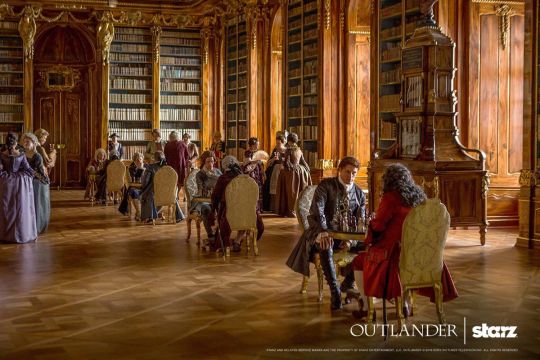
While in Paris, JAMMF is acting, in plain sight, as a diplomatic agent of sorts on behalf of Bonnie Prince Charlie's embryo of a government in exile. Desperately hoping and fruitlessly waiting for more. And making a very bad, emotional job of it all, when emotions are least needed, despite all those best laid plans. Still, he does exactly what a diplomat posted abroad would do. He meets all the important honchos, he brilliantly entertains all those people at his open table, he mingles with princes and beggars alike and of course, he dutifully reports in writing about all this, back to Scotland.
It is, therefore, a pity and a shame that Herself did not utter a single word, in Dragonfly in Amber, about the real Jacobite meeting place in Paris: Sorbonne's Collegium Scoticum/Scots College, or Collège des Écossais, founded in 1333, by an edict of the Parliament of Paris (what we would call today the local council) and as a belated, yet important consequence of the Auld Alliance treaty between France, Scotland and Norway:
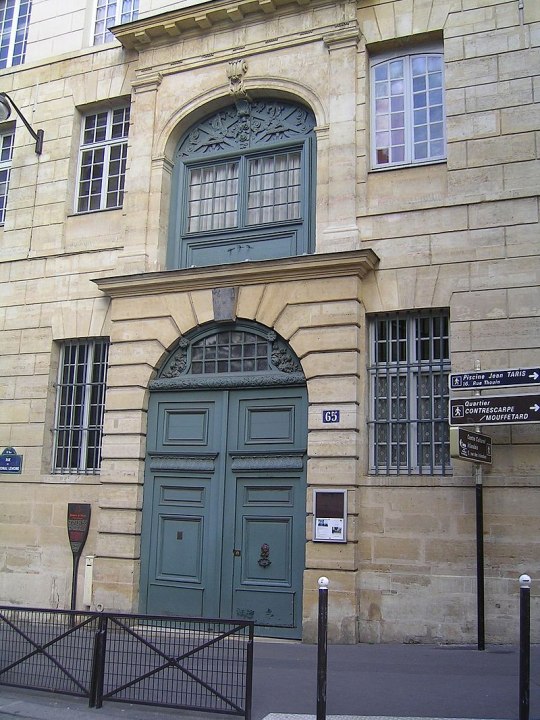
This is a place with a rich and minutely documented history, so much so that the adjoining street soon came to be known as the rue des Ecossais (Scots' Street), instead of rue des Amandiers (Almond Tree Street).
The building is still there, albeit with a different destination, a private Catholic elementary school. And a plaque inside the main building tells part of the story, in Latin:
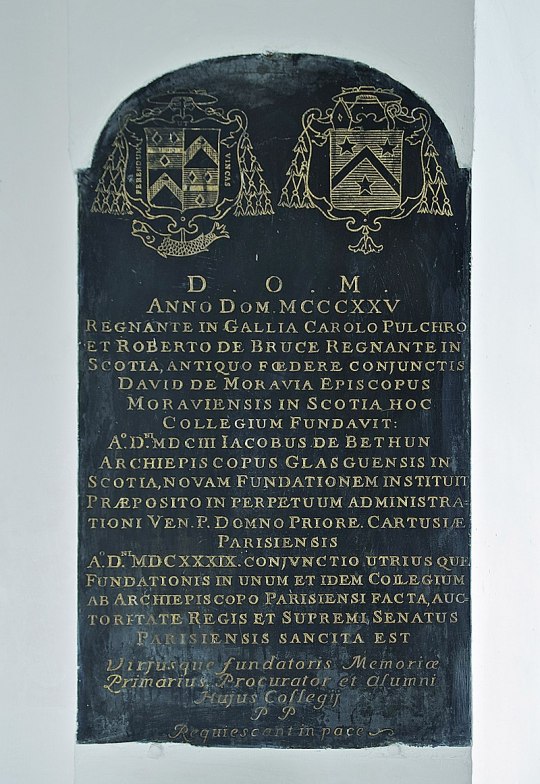
Meaning:
In 1325, under the reigns of Charles the Fair, in France and Robert the Bruce, in Scotland, David de Moravia, bishop of Murray founded this college. In 1604, Jacques de Bethun, archbishop of Glasgow made a seminary out of it, given to the perpetual administration of the Carthusian Order's Superior of Paris [later edit, forgot to translate that properly and the French version I eventually took out is incomplete, sorry!]. In 1639, the whole was placed under the authority of the King of France and the Archbishop of Paris, their supreme authority being solemnly ratified by the Parliament of Paris. In memory of the founders, the priests and the alumni, may they rest in peace!
[Later edit]: the eight year difference in records reflects the time it took for the Parliament of Paris to acknowledge the College's existence and offer its due legal protection. So: founded by the bishop of Murray in 1325 and legally authorized by the Parliament of Paris in 1333. Both dates are legit founding landmarks and can be quoted accordingly.
64 notes
·
View notes
Text
Live TV Broadcast on Francesim 2, Special Edition ‘Oliver and Hortense, The Royal Wedding’
👉🏻 Follow Hortense's wedding on the blog @officalroyalsofpierreland

Statement by Jérôme Leicca, Head of the Emperor's Household, at the Press Conference on the Marriage of Hortense and Oliver of Scots.
Ladies and Gentlemen, members of the press,
This royal marriage marks an important and symbolic moment for our two nations, and I am here to clarify the new legal and protocol situation of Her Royal Highness, Princess Hortense, to the French people.
Princess Hortense, in marrying Prince Oliver, has acquired a new status as Princess of the Scots. She will henceforth be referred to as "Her Royal Highness, Princess Hortense." This title is a recognition of her integration into the Scottish royal house and her new role within it.
This new status takes precedence over her French title, which she nevertheless retains as the sister of the Emperor of the French. This retention has been approved by His Imperial Majesty, Emperor Napoleon V, in accordance with imperial tradition and the provisions of our Constitution. Thus, her full title is: "Her Royal Highness, Princess Hortense of the Scots, Duchess of Rothsey, Countess of Carrick, Lady of the Isle of Sky, Madame de Francesim."
As a member of the imperial family, Princess Hortense will continue to enjoy certain protocol privileges when she is in our country, in her capacity as Madame. However, her main responsibilities and commitments will now focus on her duties as the wife of the Prince of the Scots.
The official functions and protocol engagements of the Princess in Francesim will be coordinated in close collaboration with the Scottish Royal Household to ensure harmony and consistency in her activities. It should be noted that Her Royal Highness will continue her studies in Francesim at the École Polytechnique for two more years. We kindly ask journalists to respect the privacy of the Princess and the newlywed couple while on French soil.
In accordance with Article 2 of the Imperial Constitution, the children of Their Royal Highnesses will not have any rights of succession to the throne of Francesim. They will hold dual Franco-Scottish nationality but will not have any French imperial privileges.
This event strengthens the bonds of friendship and cooperation between the empire of Francesim and the kingdom of Scotland. It symbolizes the unity and fraternity of our two nations, and we look forward to increased cultural and diplomatic exchanges as a result. The members of the Emperor's Household, with whom the Princess grew up, wish to express their warmest wishes for her marriage to the Prince Oliver.
⚜ Traduction française
Emission télévisée en direct sur Francesim 2, édition spéciale "Oliver et Hortense, le mariage royal"
Déclaration de Jérôme Leicca, Chef de la Maison de l'Empereur, lors de la Conférence de Presse sur le Mariage d'Hortense et d'Oliver d'Écosse.
Mesdames et Messieurs, membres de la presse,
Ce mariage royal marque un moment important et symbolique pour nos deux nations, et je suis ici pour clarifier la nouvelle situation légale et protocolaire de Son Altesse Royale, Hortense, auprès des Français.
En épousant le prince Oliver, Madame a acquis un nouveau statut en tant que Princesse des Ecossais et duchesse de Rothsey. Elle sera désormais désignée sous le prédicat "d'Altesse royale, Princesse Hortense". Ce titre est une reconnaissance de son intégration dans la maison royale écossaise et de son nouveau rôle au sein de celle-ci.
Il prévaut désormais sur son titre français, qu'elle conserve néanmoins en tant que sœur de l'Empereur. Ce maintien a été approuvé par Sa Majesté Impériale, l'Empereur Napoléon V, en accord avec la tradition impériale et les dispositions de notre Constitution. Ainsi, le titre complet est : "Son Altesse Royale, la Princesse Hortense des Ecossais, Duchesse de Rothsey, Countess of Carrick, Lady of the Isle of Sky, Madame de Francesim".
En tant que membre de la famille impériale, la princesse Hortense continuera �� jouir de certaines prérogatives protocolaires lorsqu'elle se trouve en notre pays, en qualité de Madame. Cependant, ses responsabilités et engagements principaux seront désormais centrés sur ses devoirs en tant qu'épouse du prince des Ecossais.
Les fonctions officielles et les engagements protocolaires de la Princesse en Francesim seront coordonnés en étroite collaboration avec la Maison Royale d'Écosse pour assurer une harmonie et une cohérence dans ses activités. Il faut préciser que Son Altesse Royale poursuivra encore deux ans ses études en Francesim, à l'Ecole Polytechnique. Nous demandons donc aux journalistes de bien vouloir respecter l'intimité de la Princesse et du jeune couple marié sur le sol français.
Conformément à l'article 2 de la Constitution impériale, les enfants de Leurs Altesses Royales n'auront pas de droits de succession au trône de Francesim. Ils auront la double nationale franco-écossaise, mais n'auront aucun privilège impérial français.
Cet événement renforce les liens d'amitié et de coopération entre la Francesim et l'Écosse. Il symbolise l'unité et la fraternité de nos deux nations, et nous nous réjouissons des échanges culturels et diplomatiques accrus qui en découleront. Les membres de la Maison de l'Empereur, auprès desquels la Princesse Hortense a grandi, souhaitent exprimer leurs vœux les plus chaleureux pour son mariage avec le prince Oliver.
#simparte#ts4#ts4 royal#royal simblr#sims 4 royal#sims 4 fr#sims 4#ts4 royalty#sims 4 royalty#sim : hortense#sim : oliver#collab : pierreland#theweddingofoliverandhortense#worldbuilding#frenchimperialprotocol#sim : jérôme#sims 4 royal family#sims 4 royal simblr#ts4 royal family#ts4 royal simblr#sim : louis
34 notes
·
View notes
Photo

Facebook memories inflicted this horror upon me - a decade ago, 21-year-old me on his first day of reenacting, on-site at Culloden. To think my first impression was Royal-Ecossais! Though to be fair, I had been dreaming of working there for as long as I could remember.
41 notes
·
View notes
Text






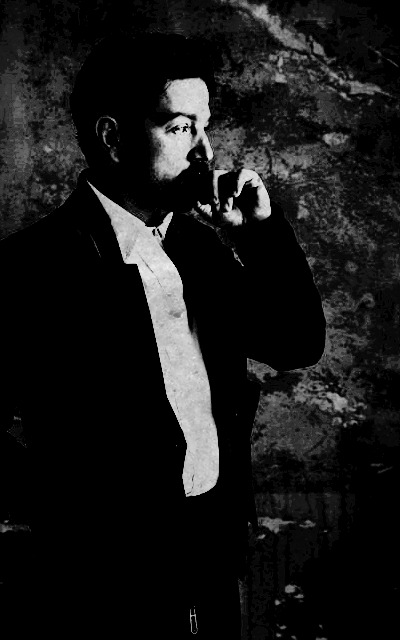
Diego Luna x7
-FC Masculin ; Mexicain, Anglais, Ecossais ; 1979
Aka Belzebuth le GOAT sur Crown of Serpents
#forum rpg#ressources rpg#libre service#ressource rpg#forumactif#rpg francophone#rpg ressources#french rpg#rpg français#400*640#diego luna avatar#diego luna avatars#diego luna 400*640
8 notes
·
View notes
Text
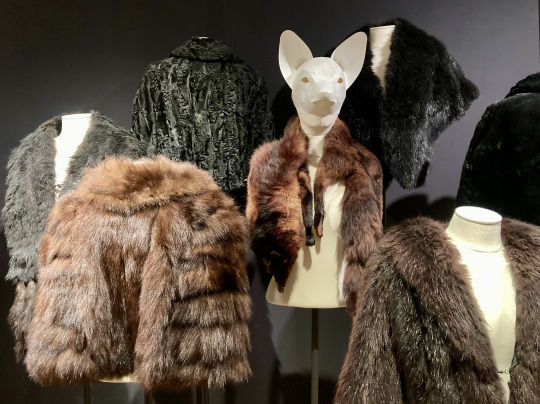
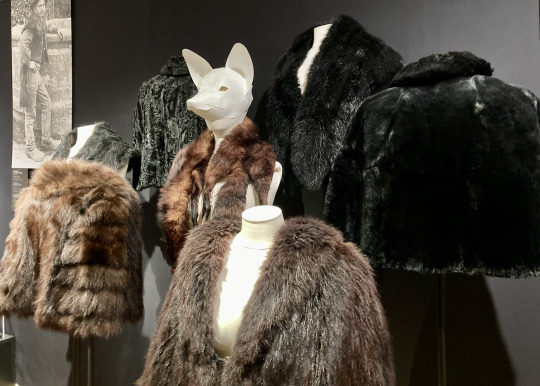
“Pèlerines" en fourrure de sconse ou moufette et "Ecossais " en peau de renard (1900-60) présentés à l'exposition "De la Bête à l'Habit" du Musée Départemental Breton à Quimper, Bretagne, décembre 2023.
7 notes
·
View notes
Text

"On croit que c'est facile de ne rien faire du tout, au fond c'est difficile, c'est difficile comme tout. Il faut passer le temps, c'est tout un travail,
il faut passer le temps, c'est un travail de titan. Ah, du matin au soir je ne faisais rien, rien.
Ah, quelle drôle de chose du matin au soir, du soir au matin, je faisais la même chose, rien. Je ne faisais rien, j'avais les moyens.
Ah, quelle triste histoire, j'aurais pu tout avoir, oui ce que j'aurais voulu, si je l'avais voulu, je l'aurais eu. Mais je n'avais envie de rien, rien.
Un jour pourtant je vis un chien, ce chien qui me plut, je l'eus. C'était un grand chien, un chien de berger, mais la pauvre bête, comme elle s'ennuyait, s'ennuyait de son maître, un vieil Ecossais.
J'ai acheté son maître, j'avais les moyens. Quel drôle d'écho, oh ! Quel drôle d'Écossais c'était que le berger de mon chien.
Toute la journée il pleurait, toute la nuit il sanglotait. Ah, ! c'était tout à fait insensé, l'Ecossais dépérissait.
Il ne voulait rien entendre, il parlait même de se pendre. J'aime mieux mes moutons, chantait-il en écossais, et le chien aboyait en l'entendant chanter.
J'avais les moyens, j'achetai les moutons. Je les mis dans mon salon.
Alors, ils broutèrent mes tapis, et puis ils crevèrent d'ennui, et dans la tombe, l'Écossais les suivit et le chien aussi.
C'est alors que je partis en croisière, pour r-me-calmer-me petits-nerfs..."
Jacques Prévert
"Il faut passer le temps"
2 notes
·
View notes
Text


On August 18th 1746 Arthur Elphinstone, Lord Balmerino and William Boyd, 4th Earl of Kilmarnock the Jacobite nobles, were executed.
The two were found guilty of treason and sentenced to death; this was commuted to beheading, rather than the usual sentence of Hung,drawn and quartered, which had already been carried out on some Jacobites, most notably the English Jacobite Francis Towneley on 30th July that year, with eight of his comrades from the Manchester Regiment.
Everyone who was anyone wanted to be at the execution, among the spectators was the English army officer and naturalist George Montagu, it is his description that I have pinched for an eye witness account of the gruesome events that day in 1746. Montagu was allowed close access to the prisoners from before their trial until they met their end.
Just before they came out of the Tower, Lord Balmerino drank a bumper to King James’s health. As the clock struck ten they came forth on foot, Lord Kilmarnock all in black, his hair unpowdered in a bag, supported by Forster, the great Presbyterian, and by Mr. Home, a young clergyman, his friend. Lord Balmerino followed, alone, in a blue coat turned up with red, his rebellious regimentals, a flannel waistcoat, and his shroud beneath; their hearses following.
They were conducted to a house near the scaffold; the room forwards had benches for spectators; in the second Lord Kilmarnock was put, and in the third backwards Lord Balmerino; all three chambers hung with black. Here they parted! Balmerino embraced the other, and said,
“My lord, I wish I could suffer for both!” He had scarce left him, before he desired again to see him, and then asked him, “My Lord Kilmarnock, do you know any thing of the resolution taken in our army, the day before the battle of Culloden, to put the English prisoners to death?”
He replied, “My lord, I was not present; but since I came hither, I have had all the reason in the world to believe that there was such order taken; and I hear the Duke has the pocketbook with the order.”
Balmerino answered, “It was a lie raised to excuse their barbarity to us.” –Take notice, that the Duke’s charging this on Lord Kilmarnock (certainly on misinformation) decided this unhappy man’s fate! The most now pretended is, that it would have come to Lord Kilmarnock’s turn to have given the word for the slaughter, as lieutenant-general, with the patent for which he was immediately drawn into the rebellion, after having been staggered by his wife, her mother, his own poverty, and the defeat of Cope.
I’ll interject here this conversation pertained to the lie that the Jacobite commanders issued an order that “no quarter” was to be give ‘no quarter’ meant that no prisoners would be taken. Any men on the battlefield would have no mercy shown to them and surrender would not be accepted.
On the eve of the Battle of Culloden the Duke of Cumberland was determined to end the Jacobite Rising and prevent the Jacobites from ever being capable of challenging the throne again. After losing to the Jacobites at every turn, up to this point, he would not let them win again. To motivate his men he informed them that Lord George Murray had ordered ‘no quarter’ to be given to the Government men on the field. This meant the men would be shown no mercy by the Jacobites . However, this claim was not true. No such order had been given.
From copies of Lord Murray’s orders there was no mention of ‘no quarter’ anywhere. But, in Cumberland’s papers there was a copy in which the words ‘and to give no quarters to the electors troops on any account whatsoever’ had been inserted. Whilst Cumberland may not have been responsible for doctoring the order he certainly did not shy away from the words written and retaliated in kind.
After the battle Cumberland ordered his men to search out any surviving rebels who were to be treated as traitors, outside the conventions of international combat. Those with the Royal Ecossais or the Irish Piquet’s would be regarded as prisoners of war but everyone else was to be considered traitors. Whilst some men in the government army refused to kill, and tried to turn a blind eye, there were some who committed terrible acts. As well as wounded soldiers, civilians, women and children were all killed in the horrible aftermath of Culloden.
Back to Montagu’s account…..
He (Kilmarnock) remained an hour and a half in the house, and shed tears. At last he came to the scaffold, certainly much terrified, but with a resolution that prevented his behaving in the least meanly or unlike a gentleman. He took no notice of the crowd, only to desire that the baize might be lifted up from the rails, that the mob might see the spectacle.
He stood and prayed some time with Forster, who wept over him, exhorted and encouraged him. He delivered a long speech to the Sheriff, and with a noble manliness stuck to the recantation he had made at his trial; declaring he wished that all who embarked in the same cause might meet the same fate.
He then took off his bag, coat and waistcoat with great composure, and after some trouble put on a napkin-cap, and then several times tried the block; the executioner, who was in white with a white apron, out of tenderness concealing the axe behind himself. At last the Earl knelt down, with a visible unwillingness to depart, and after five minutes dropped his handkerchief, the signal, and his head was cut off at once, only hanging by a bit of skin, and was received in a scarlet cloth by four of the undertaker’s men kneeling, who wrapped it up and put it into the coffin with the body; orders having been given not to expose the heads, as used to be the custom.
The scaffold was immediately new-strewed with saw-dust, the block new-covered, the executioner new-dressed, and a new axe brought. Then came old Balmerino, treading with the air of a general. As soon as he mounted the scaffold, he read the inscription on his coffin, as he did again afterwards: he then surveyed the spectators, who were in amazing numbers, even upon masts of ships in the river; and pulling out his spectacles, read a treasonable speech, which he delivered to the Sheriff, and said, the young Pretender was so sweet a Prince that flesh and blood could not resist following him; and lying down to try the block, he said, “If I had a thousand lives, I would lay them all down here in the same cause.”
He said, if he had not taken the sacrament the day before, he would have knocked down Williamson, the lieutenant of the Tower, for his ill usage of him. He took the axe and felt it, and asked the headsman how many blows he had given Lord Kilmarnock; and gave him three guineas. Two clergymen, who attended him, coming up, he said, “No, gentlemen, I believe you have already done me all the service you can.” Then he went to the corner of the scaffold, and called very loud for the warder, to give him his periwig, which he took off, and put on a nightcap of Scotch plaid, and then pulled off his coat and waistcoat and lay down; but being told he was on the wrong side, vaulted round, and immediately gave the sign by tossing up his arm, as if he were giving the signal for battle. He received three blows, but the first certainly took away all sensation. He was not a quarter of an hour on the scaffold; Lord Kilmarnock above half a one. Balmerino certainly died with the intrepidity of a hero, but with the insensibility of one too.
9 notes
·
View notes
Text
“Je ne vois pas pourquoi il faudrait protéger les races animales et laisser périr les peuples tels qu’ils ont été façonnés par des milliers d’années de longue patience.La véritable écologie, c’est de sauvegarder les baleines. Mais aussi les Touaregs et les Zoulous, les Basques et les Serbes, les Flamands et les Bretons, les Ecossais et les Estoniens.”
Jean Mabire

10 notes
·
View notes
Text

Journal des Dames et des Modes, Costume Parisien, 20 juin 1807, (816): Fichu de Filet. Rubans Ecossais. Collection of the Rijksmuseum, Netherlands
Woman, reaching for a butterfly, holding a bouquet of flowers in her left hand. She wears a dress with short puffed sleeves, high waist with a belt of Scottish checked ribbon. Around the neck a fichu of 'filet'. Long mittens. The print is part of the fashion magazine Journal des Dames et des Modes, published by Pierre de la Mésangère, Paris, 1797-1839.
#Journal des Dames et des Modes#19th century#18aughts#1807#on this day#June 20#periodical#fashion#fashion plate#color#description#rijksmuseum#dress#fichu#Mésangère
44 notes
·
View notes

